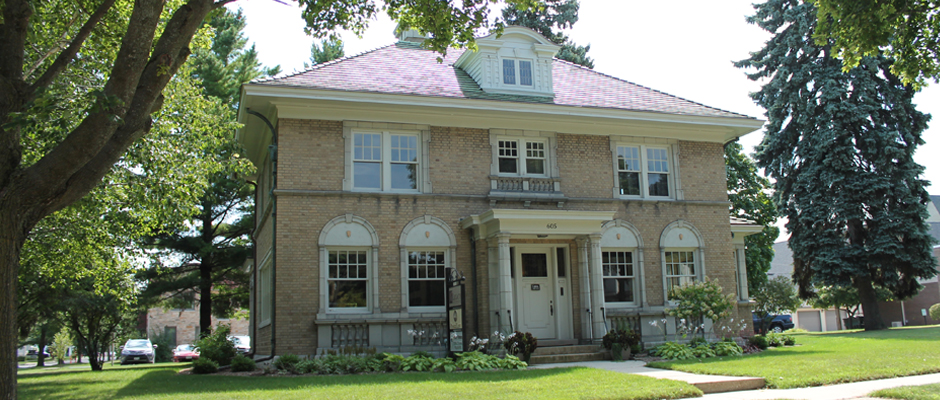Back to Life - Local Architect Tackles Restoration of Prange Home
Schultz, Deanne. The Sheboygan Press, January 10, 2015, page A1.
When she decided to move her business to the house at 605 Erie Ave., Jennifer Lehrke, owner of Legacy Architecture in Sheboygan, had no idea how enmeshed she'd become in the life of Eliza Prange, 605's original owner.
Lehrke jumped at the opportunity to buy the house when it was offered for sale by the St. Mark Lutheran Church board of trustees, which owned it since 1947, using it as a parsonage before closing it up in 1998.
Carol Koffarnus, a member of St. Mark, said the trustees had narrowed its options down to three - restore the home for the church's use, sell it to a private owner, or demolish it.
"The Prange family had such an important influence in Sheboygan's history, and Eliza's house is really the only monument left to that," the church decided to sell it to someone that would restore the home, Koffarnus said.
Eliza's home, designed by W.C. Weeks, a Sheboygan-area architect, caught the eye of Lehrke a few years earlier.
"I respect his work," she said. "This was our opportunity to save a building... and restore a piece of Sheboygan's history."
Beth Dippel, executive director of the Sheboygan County Historical Research Center, agreed.
"Historical buildings must be saved because we need to preserve the marks left on our national landscape by those who shaped it," she said.
Represents a legacy
Dippel called the preservation of historic buildings "a one-way street. There is no chance to renovate or to save a historic site once it's gone. With the old Prange's store gone and most of the family living elsewhere, the Prange legacy is well represented" in 605 Erie Avenue.
The house, built in 1923, cried out for renovation - almost nonexistent insulation caused skyrocketing heating bills; the clay tile roof needed refurbishing, and the electrical system required replacement.
Lehrke digested all this and remained undaunted. She's participated in several remarkable historical renovations in the area - including the Stephanie Weill Center, Faye's Pizza and Restoration Gardens - and knew she could bring 605 Erie back to its former glory.
"The rich woodwork and crown moldings, leaded-glass doors, built-in cabinetry," she said. "It was an opportunity to share a piece of history with the community and showcase our work."
Before the dust flew, though, Lehrke and her team scoured the house's history in an attempt to learn more about it and Eliza Prange.
Eliza, the youngest of seven children, was born in 1862. She lived on the family farm until her mother's death in 1887, then moved to Sheboygan where her brother, Henry Carl (H.C.) Prange worked as a store clerk.
Rose through the ranks
In 1887, H.C., Eliza, and their brother-in-law, John H. Bitter, opened the first H.C. Prange store. They incorporated the business in 1898, with H.C. serving as president, Bitter as vice president, Otto J. Kohl as secretary and Eliza as treasurer.
In an age when many women of her station didn't pursue a career outside the home or their well-defined role in society, Eliza rose through the corporate ranks, holding many roles within the company over the span of 41 years, from clerk to vice president.
Dippel called Eliza "exceptional in many ways. (She) was a business pioneer, understanding and putting into action business practices far ahead of their time. In an era when women were just coming into their own in the business world, Eliza was a model."
By the time 1923 rolled around, H.C. Prange Co. completed construction on a new, larger department store. Over 400 employees worked for the Pranges, selling everything from rugs and draperies to jewelry, domestics and footwear and art goods.
That year, Eliza used her own money to build the two-story, Mediterranean-style brick mansion at 605 Erie. Graceful arches curve over leaded-glass windows, with a columned entrance covering massive wooden front doors.
A generous bank of windows in the living room admitted light from the rising sun, falling on the intricately carved tiles surrounding the fireplace on the opposite wall.
Upstairs, Eliza's bedroom boasted the same east-facing view, with a smaller room for her sister and another servant's bedroom beyond.
Life cut short
Eliza didn't have long to enjoy her beautiful home - five years later, in 1928, she died unexpectedly. While placing flowers on H.C.'s grave, Eliza, who had her back to the road, was pinned underneath her car when it rolled off the road and over her. She died less than nine hours later.
As if her remarkable life and house weren't enough fodder for the imagination, Lehrke then learned of Eliza's legacy.
"In her will, she left the equivalent of $4.2 million in today's dollars to charities," Lehrke said.
Part of that money was instrumental in the formation of what is now Memorial Hospital.
But even before her death, Eliza worked quietly in the community. Lehrke said that some of Eliza's fellow parishioners, facing hard times, would find themselves the beneficiary of money and food, arriving with no name attached.
Great reverence
"It was from her - she would just do this silently, quietly, so no one knew," Lehrke said.
So it was with great reverence that Lehrke began the painstaking efforts of returning the house to its original state.
Roofers, skilled in the installation of clay tiles, were hired to repair the 91-year-old roof. Craftsmen with the hands and mind of those working in the early part of last century are now repairing woodwork and heavy doors, creating replicas for those with water damage.
"I wanted to maintain the historical integrity of the house," Lehrke said. "We're fixing it the historically appropriate way."
Standing on the sidewalk in front of the house, the sound of saws buzzing within, and workers, crawling like bees up the scaffolding outside, Lehrke contemplated the mission she and her team are undertaking.
"Everything happens for a reason," she said. "I spent many years...driving past the building twice a day, admiring it. (Eliza) was an exceptional businesswoman, and I can only hope to aspire to her level of success."

